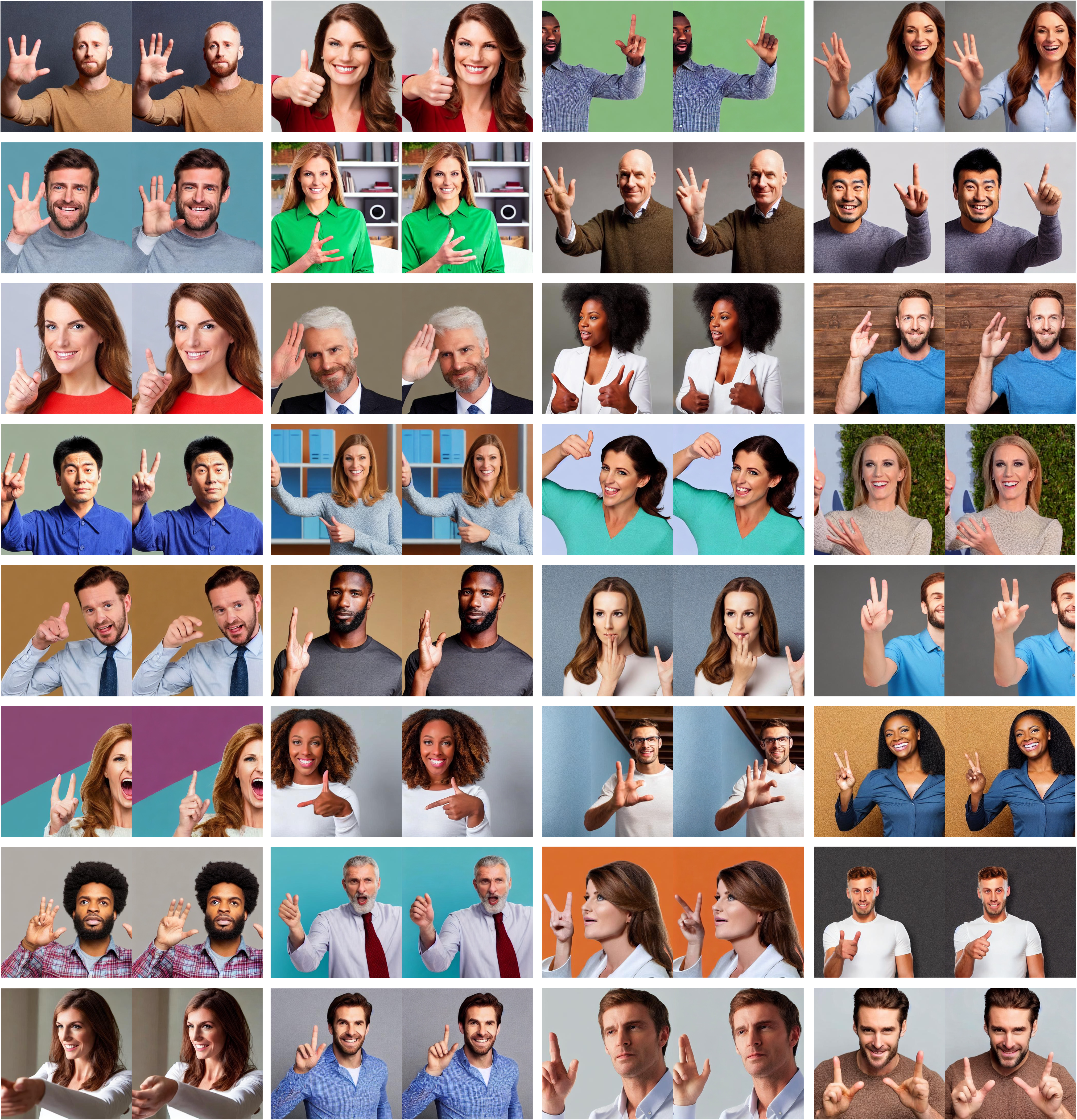2023.12.1 The paper is post on arxiv!
2023.12.29 First code commit released.
This is the official repository of the paper HandRefiner: Refining Malformed Hands in Generated Images by Diffusion-based Conditional Inpainting
Figure 1: Stable Diffusion (first two rows) and SDXL (last row) generate malformed hands (left in each pair), e.g., incorrect number of fingers or irregular shapes, which can be effectively rectified by our HandRefiner (right in each pair).
In this study, we introduce a lightweight post-processing solution called HandRefiner to correct malformed hands in generated images. HandRefiner employs a conditional inpainting approach to rectify malformed hands while leaving other parts of the image untouched. We leverage the hand mesh reconstruction model that consistently adheres to the correct number of fingers and hand shape, while also being capable of fitting the desired hand pose in the generated image. Given a generated failed image due to malformed hands, we utilize ControlNet modules to re-inject such correct hand information. Additionally, we uncover a phase transition phenomenon within ControlNet as we vary the control strength. It enables us to take advantage of more readily available synthetic data without suffering from the domain gap between realistic and synthetic hands.
Check installation.md for installation instructions.
Check manual.md for an explanation of commands to execute the HandRefiner.
For single image rectification:
python handrefiner.py --input_img test/1.jpg --out_dir output --strength 0.55 --weights models/inpaint_depth_control.ckpt --prompt "a man facing the camera, making a hand gesture, indoor" --seed 1For multiple image rectifications:
python handrefiner.py --input_dir test --out_dir output --strength 0.55 --weights models/inpaint_depth_control.ckpt --prompt_file test/test.json --seed 1- What kind of images can be rectified?
- Can we use it on SDXL images?
In the paper, the SDXL images are resized to 512x512 before the rectification, because the base model used in this project is sd1.5. Solution for SDXL: However, it is certainly not difficult to implement it in SDXL, and I believe many implementations already have the functionality of using inpainting SDXL combined with depth controlnet to inpaint the image. So what you can do is get the depth map and masks from the pipeline of this repository, then pipe them to the whatever implementation for SDXL you use for inpainting the image. A caveat is that I have not tested this before, and as mentioned in the paper, since depth controlnet is not fine-tuned on the hand mesh data, it may have a high rate of failed inpainting. In that case, you can use the technique mentioned in the paper, using available synthetic data to fine-tune the depth sdxl controlnet, for example, using these two datasets here [1][2], then you can adjust control strength to get the desired texture and appearance.
- What if the generation failed?
The first thing is to check the depth map, if the depth map is bad, you can consider using a different mesh reconstruction model to reconstruct the mesh.
Second things is to check if the masks of hands fully cover the malformed hands, some malformed hand can have very long fingers so it may not be covered by the detected masks, to fix this
- Consider using a greater padding by adjusting the pad parameter in the argument
- Provide a hand-drawn mask
If all of the previous steps are ok, then you may need to regenerate several times or try different control strengths. <- changing the seed can be very helpful.
- Since the small hands is a limitation mentioned in the paper, what is the appropriate hand size for the SD v1.5 weight?
Generally, hands with size at least 60px × 60px is recommended for the current weights. To make it applicable for small hands, consider scale up the image using some super-resolution methods.
- How to contribute to this project?
In the last decade, the CV community has produced dozens of highly accurate mesh reconstruction models, in this project we use the recent SOTA model Mesh Graphormer on the FreiHAND benchmark. However, it is very welcome to contribute to this project by porting other models here, I have written a template parent class for models under preprocessor folder.
- Why use other model if Mesh Graphormer is already SOTA?
In this project, we leverage mesh reconstruction model to project these malformed hands onto a reasonable pose space, Mesh Graphormer is only SOTA in terms of reconstructing mesh given correct hand pictures. In particular, Mesh Graphormer utilises a model-free approach to reconstruct hand mesh, through our experiments, this approach is usually more accurate (i.e., more natural appearance ) but less robust (i.e., higher failed reconstruction rate). Another common approach is model-based which uses a parametric deformable hand model to reconstruct mesh, this approach is usually more robust (i.e., lower failed reconstruction rate) but less accurate (i.e., less natural appearance).
- Can I use it for Anime hands or other styles?
As long as the hand detection model and the mesh reconstruction model are able to detect the hands and reconstruct meshes, it should work for other styles. However, from my understanding, these models are not trained on cartoon or anime images, so there is a great chance that the mesh reconstruction stage may fail.
Like any method, this method also has its limits. If the original hands are so bad that are inrecognisable from human eyes, then it is pretty much impossible for neural networks to fit a reasonable mesh. Also, due to the fitting nature of the method, we do not rectify the hand size. So if you have a giant malformed hand in the original image, you will still get a giant hand back in the rectified image. Thus malformed hands with hand-like shape and appropriate size can be rectified.
- Our codebase builds heavily on stable-diffusion, ControlNet and MeshGraphormer.
If you find HandRefiner helpful, please consider giving this repo a star ⭐ and citing:
@misc{lu2023handrefiner,
title={HandRefiner: Refining Malformed Hands in Generated Images by Diffusion-based Conditional Inpainting},
author={Wenquan Lu and Yufei Xu and Jing Zhang and Chaoyue Wang and Dacheng Tao},
year={2023},
eprint={2311.17957},
archivePrefix={arXiv},
primaryClass={cs.CV}
}


